HALLER PARK - FROM WASTELAND TO PARADISE
In August 1964 I joined Bamburi Cement Co. Ltd. Mombasa (Kenya) as Chief structural engineer (civil) at the time when major extensions were underway already. Bamburi Portland Cement Works started up the two shaft kilns producing cement clinker out of dead coral rock technically for the first time in 1954. For almost 22 years I was involved in all civil constructions for the same Works that achieved a rated capacity of total 1,250.000 metric t/year with 6 shaft kilns (Von Roll & Krupp) and 2 Humbold-Wedag 4 stage Preheater rotary kilns at the time of my retirement in 1987.
The works excavate from quarry over 900,000 tons of fossil coral limestone
annually that is then burned into cement clinker. The excavation depth
dependents on either of the silica content in raw excavated material or
on the ground water table that underlies the quarry whole area. The quarry
floor consists mainly of very hard porous fossil coral limestone containing
minerals of silica, alumina and iron oxides and the calcium carbonate dominating.
The constantly expanding scar in the pleasant coastal landscape concerned
the Company's management and one decided starting an experiment aiming
to rehabilitate of the whole area and to hide that
ugly scar as soon as possible.
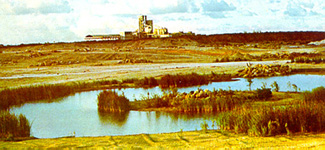
View N-W at the begin of quarry rehabilitation with its first large
pond in use already.
During my regular visits to the Works I was rather interested with the project of the quarry rehabilitation and followed its progress since it began in 1971. Almost every year I visited the Bamburi Nature Trail and continuing it after my retirement in the company of my wife and grandchildren on few occasions too. I'd like to report on a few technical data first to be followed by some most important explanations regarding the natural development in this sanctuary that may interest the readers too.
GEOGRAPHY AND CLIMATE
The quarry sites is exactly 4º South of the equator and 139º 44' east of the Greenwich meridian and is situated 8 km north of Mombasa Island, stretching along the north west side of the Mombasa - Malindi road some 500 - 600 m inland from the seashore. One excavated up to depth of 10m that that is to approx. 50 cm above the mean ground water table (at +20 cm of mean sea level).
The sites are in tropical climate where rain can fall every month although not reliably as 35 - 77 % of the annual total falls during April-June period. The average annual rainfall over is about 1192 mm with maximums over 2056 mm (1968 or 1997) and a minimum of 561 mm (1898). Number of rain days varies say from 94 to 142 - a disastrous rainfall occurred in 1997 year (El Nino). The mean temperature does not vary much reaching its maximum in March of 28.8º C and dropping to 24.7º C in July and August. The average relative humidity varies too with lowest reading of 69% say in February and 81% say in May. The maximum readings are obtained before sunrise at 99 % and the minimum ones in the afternoon of 60%. The coastal region around Mombasa has two monsoon currents: the southeast monsoon during months of May to beginning of October, and the northeast one from November to March. There is normally a light land breeze during the night.
QUARRY REHABILITATION PROJECT
Corals, often called "flowering animals", usually live in big colonies. Each single animal excretes a skeleton of calcium carbonate, and whole colonies build sophisticated, compacted constructions, which may stretch over wide areas. The coral animals cannot thrive in water temperatures below 20 degrees Celsius, and are dependent on shallow seas for growth. They require sunlight, which filters through layers that expanded over area from which one excavates some 1.2 million tons of coral limestone at present annual cement sale.
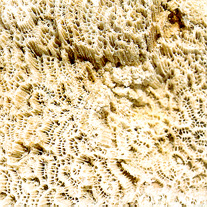
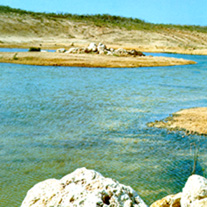
The dead coral is porous limestone - the main
Excavated large ground water pond had to be
mineral component for cement manufacturing.
fertilized to stimulate any growth of algae etc.
The first quarry pit excavated to say 9m depth had an area of 2 km² what was once secondary bush land. Its floor became an inhospitable wasteland some 50 cm above brackish ground water level. The idea of quarry rehabilitation was to make it into a good landscape combined with attractiveness and utility. One expected that certain varieties of trees could be grown in the barren floor with a ground water table between 15-20 cm below it. The vertical movement of ground water table is related to tides with a six hour delay that is, when there is a high tide at seas then is a low tide of quarry's ground water level and vice versa. The maximum movement within six hours is 20 cm with a maximum difference of 31 cm between highest and lowest readings.
It was important to ascertain these vertical ground water movements too as one intended to construct fishponds by deeper excavation of the quarry's floor. The ponds' depth depended upon water salinity that is as the excavation deepens the salinity increases. The soft water layer on top the brackish ground water is in average 15 cm thick only. The samples were taken from several ponds at different depths to measure TDS (Total dissolved solids) that varies from 2600 ppm (parts per million) during dry seasons January-March to a minimum of 800 ppm in rainy seasons mostly in May. Water samples were taken just below the floor and a meter below it at the depth from where water would be pumped into fish tanks and readings were slightly less saline ranging from 1800 to 200 ppm. The water pH-value was about 7.4 with temperatures of ground water varying between 24º and 32º C.
WHAT TO ACCOMPLISH ON A WASTELAND?
René Haller recalled that ugly wasteland expanding annually by ten thousands of m² and was appalled that in the oldest quarry parts no plants had been able to establish themselves. Spending countless hours down there in the quarry's hot and dusty barren land he found a few ferns only. Also perhaps half a dozen tiny bushes and grasses were struggling to take root sheltered behind some remaining rocks. It was not an encouraging environment for tree planting though but one day he discovered in a quarry's isolated part five small "Casuarina" trees and two date palms.
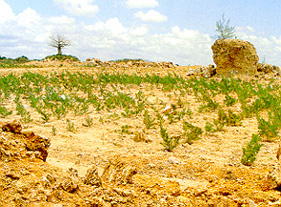
First planting of Casuarinas was a tentative and painstaking trial under
incessant
scorching tropical sun in a limestone wasteland with brackish water
beneath
The most important task was to find pioneer plants that could survive in the limestone desert in that there was no humus and only brackish water. The plants had to endure the unrelenting fierce tropical sun too so 26 varieties of saplings were planted. Only three of them survived: the "dames" Conocarpus lancifolius, a salt tolerant tree from the coast of Somalia; the "coconut palm" Cocos nuciferc and the "whistling pine", Casuarina equisetifolia, a tree which originates from Australia. Casuarina is a kind of pioneer tree adapted to grow under severe conditions whose leaves are reduced to minute tips arranged like branchlet's whorls around an equisetum giving a good protection against evaporation. The branchlets look like pine needles and have a strong outer surface skin. Furthermore, Casuarinas can tolerate salty water and the young trees were progressing well as this harsh environment seemed to be ideal for them.
Before the rehabilitation work was started in 1971 some ferns grew sheltered behind big rocks that couldn't be crushed. Also Tamarix nilotica germinated probably imported with gypsum from Tana River that was required in the production. Some 12,000 tree's samplings were planted between January 1971 and March 1974 in an area of about 13 hectares (32 acres). Two methods were applied in the preparation for planting: 1) Holes of 30x45 cm chiseled out of coral rock most of them reaching the water table or at least humid rock bed. Local heavy clay soil ("black cotton" soil) was mixed with one shovel of farmyard manure to fill a hole. 2) The ground was ripped crosswise by bulldozers and the nearby coral rag mixed with farmyard manure spread back. Both methods produce with plants good growth results. The first one was more expensive but gave more employment by digging "One Shilling Holes" on a contract basis so called. Root systems develop much faster with the other method and trees had a better chance to survive.
After 10 months of steady growth Casuarinas suddenly started yellowing and looked unhealthy. The careful scrutiny of their wild counterparts' root system growing in sand dunes would be an answer to that problem. Amongst their feeder roots were growing mulberry fruit like nodules and dense hair root structures bearing microorganisms growing in a symbiosis with Casuarina trees and contributing to their nutrient interchange. One of these microorganisms is able to fix atmospheric nitrogen, exchanging it for sugar produced in the photosynthetic process of the tree. Another group of organisms mobilizes water insoluble phosphate, potassium and other trace elements thus making them available to the tree. These observations led to soil inoculation with a selected cocktail of roots and soil from healthy Casuarinas growing on sand dunes for the ailing trees growing in quarry's sterile substrate. After several months the trees changed their color and started growing again.
REFORESTATION PROJECT
Young tree samplings came from Gede and Jilore Government Forest Stations and grew on in black polythene tubing of ø5 cm x 10 cm. They were transplanted to permanent sites when about 2030 cm high and the polythene tubing was removed then. In farm's own nursery one started growing other more important trees from their seeds too. The samplings were planted with different spacing from 2,5m to 4m of which the 2,5m spacing encouraged as the best long straight stems with few side branches and needed thinning later too. It was necessary to use a fungicide to "damp off" a fungus when raising the seedlings.
The most successful tree was "Conocarpus lancifollus" that is indigenous
to Somalia's coastal plain and was introduced to Kenya's Coast in 1950s.
It grows well in brackish water and gets rather old as well as is good
for making charcoal too. Formerly it was used for building Arab sailing
ship named "dhow" and it seems that the wood is resistant to termites too.
Soon the larger Conocarpus outgrew their original holes and penetrated
into porous coral rock with carpet like root system few centimeters below
surface down to the undisturbed rock bed deeper below. The best trees grew
to a 9-m height and to a trunk circumference of 65 cm above ground in just
three years time.
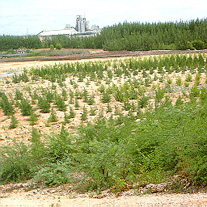
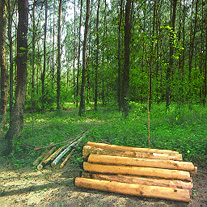
Casuarinas of various ages some seeding already. Casuarinas
enabled developing of fauna and flora.
In background the Cement Works about in 1986.
Tree trunks are used as poles, masts and firewood.
Avoiding the mono-culture planting one had chosen different kind of trees also considering their best return say as construction timber, for poles or fence posts and for charcoal production later. The two most prominent planted trees are Casuarinas and Conocarpus that have started self seeding and the young ones are now growing in between the older trees already. Some 25 different kinds of trees were planted and tested so far like Eycalyptus, Neem and Algaroba trees, few Pinus and Auracarias, the native Baobab tree, Coconut and Date palms, Banana and Mango trees etc.
One of them is the Neem tree "Azadirachta indica" that originates from India and is widely distributed along the Kenya coast too. The coastal Africans appreciate Neem tree's multiple usage and named it as "mwarobaini" meaning "a tree with forty uses". Neem tree gives abundant shade and is used as timber for construction. It has also a wide range of medicinal properties in native healing practice. Fevers such as of malaria can be cured with its leaves and bark. Leaves, bark and seed in particular contain a potent substance "azadirachtin" that is deterring insects and is used in India widely. Neem leaves successfully deter weevils in grain storage bins too. African women take certain Neem tree's product for abortions - one's told so. Africans take pencil thick Neem branches for toothbrushes as the contained substance therein prevents "periodontitis". The extracted oil from Neem tree seeds is manufactured into a soap and is used combating some skin diseases.
OBSERVING THE NATURE AND THE FOLLOW-UP APPLICATIONS
René meticulously observed nature's reacting and immediately applied the appropriate measures that could help the reforestation process. Casuarina and Conocarpus are evergreen trees that constantly drop and renew "needles" and leaves. Thus the dropping foliage was covering the rocky ground at a steady pace. However, the break down of foliage's by micro-organism was prolonged because of the high content of tannin in Casuarinas "needles''. The process of releasing the confined nutrients to other organisms was slowed down and the establishment of subsequent plant species was delayed thus.
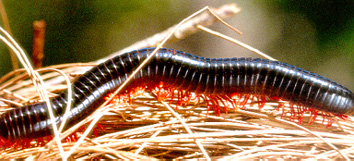
Millipedes feed almost on Casuarinas "carpet of needles" only and
convert the needles into humus with compost bacteria in their faeces.
A lucky incident solved this problem when the red legged Mombasa trains (Epibolus pulchripes) happily started feeding on dry Casuarina "needles''. The compost bacteria in millipedes' dropping converted needles into the needed humus. These useful animals were collected from coastal bushes and there was an instant success as the millipedes multiplied fast in the young forest. The leaf litter was slowly reduced and a layer of humus thickened underneath. The millipedes had found a land of milk and honey having the forest floor for them only but this happy state of affairs did not last long. Soon they became part of the food chain too as white tailed mongooses and civet cats started eating millipedes as they came in the forest on their own.
The pretty millipedes with their jet-black body and orange red legs can reach a length of 11 cm. Adult animals have up to 64 body segments with two pairs of legs each that doesn't result in 1.000 legs but in 256 "only". The animals hibernate during the dry season and hide in the deep leaf litter to protect themselves from heat and desiccation. With the first sign of rain they reappear on the surface and start mating. The dull black mate before copulation carries its shiny black male around that attaches himself on female's back with specially developed adhesive disks. The female rolls herself up under the layer of needles to lay its eggs that are laid individually and coated with fecal matter and can be distinguished from normal fecal pellets by a round even appearance. Adult millipedes are well protected from predators by a "chemical" self-defense mechanism of an acid substance that they eject causing a strong and painful reaction on the mucous membrane of most of animals, with the exception of mongooses and civet cats. The millipedes can discharge their poison up to a distance of 30 cm.
THE FOREST ECOSYSTEM - PLANTS AND INSECTS (a few examples)
Mushrooms started to appear after just a few years in darker and moister patches of the forest. At first only a single species of mushroom flourished under young trees although spores of many species were introduced hoping that some edible ones would grow in this environment. With the introduction of new tree species a greater variety of mushrooms and toadstools started appearing suddenly. With the more diverse vegetation the fungi fruit bodies became greater as well as the varieties in shape and color shooting out of soil during the rainy seasons. At the beginning of 1991 some 170 species were collected for identification already.
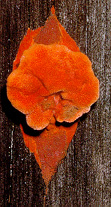
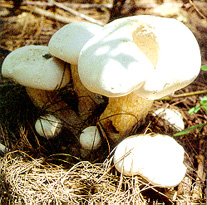
Fungi are growing not only in forest soil, but
The meat mushroom "choga nyama". Mushrooms
also on branches, trunks and mainly deadwood. and
toadstools are source of many fairy tales too.
The African workers could identify very few of flourishing mushrooms and knew two edible species in the quarry forest only. One of them named "choga nyama" or "meat mushroom" smells like boiled meat after cooking. They believe that a mushroom is edible only after it has been thrashed with a whip to chase away bad spirits hiding inside it where other mushrooms can by eaten by up-country tribes only. Coastal tribes would go crazy, dancing around naked and beating up people eating them - they believe so at least.
Termites are primarily vegetarians. Those living in deadwood and feeding on have in their intestines microscopic protistans, which break down the wood cellulose that enables them to digest it. The mound building termites subsist on various kinds of vegetable matter too. Fungi are probably important to most termites and are invariably present in decaying wood. Some termites cultivate fungi in large chambers underground in extensive fungi gardens built of spongy cellulose to be harvested there and helping them to digest cellulose matters. At the beginning of a rainy season, the termites undertake a "spring cleaning" of their fungi gardens carrying part of fungi to the surface of termite earth mounds to grow there the bodies for reproduction. At these times termite mounds are covered by thousands of small white mushroom.
Termites are generally considered a pest because they feed on soft timber for construction and furniture. In the quarry's forest ecosystem they play an important role as they eat almost any dead vegetation, in particular deadwood, brining it underground and thus making it available to soil microorganisms. The termites task is comparable to the one of millipedes but they have an important advantage by mixing the soil substrate too. The large mounds built of soil are well known although some termites move on the surface searching for food but under some kind of arcades they built of deeper soil strata.
The termite population in quarry's forested area has not gone out of control as it is checked by natural enemies as most important a variety of ant species which hunt and feed on termite's workers by invading their nests. Other animals feed on termites such as lizards, Guinea fowls and other birds too. When termite winged males and females swarm out of their mounds every insectivorous creature is their enemy. However termite eaters are kept under control by genet or civet cats and by birds of prey too.
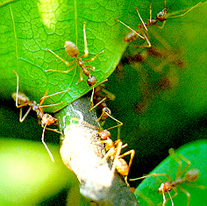
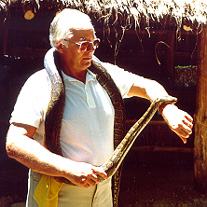
The weaver or "maji moto" ants are very aggressive
Author holds an app. 2,5m long young python
inflicting painful bites when disturbed or attacked.
from Trail's newly opened terrarium in 1987.
Ants play a vital role in any forest ecosystem but it is still little known about their secret life and functions. At times large numbers of minute black ants are observed on every tree and then they seem to vanish again when another ant's species emerges suddenly. Little is known about their feeding habits or where they build their nests. Some of the ant species feed on the excretions of aphids and scale insects. They seem to "milk" the insects by rubbing them with their mandibles until they excrete a drop of nectar like substance. One couldn't observe whether or not ants carry their "cows" with them but it looks like that they defend them.
The weaver or "maji moto" ants, as named by locals, build their nests by "weaving" leaves together. Also they defend their host trees attacking any invader man or beast inflicting painful bites, giving the sensation of being burnt by "hot water", which explains their Kiswahili name. The weaver ants were introduced to quarry's fruit tree plantation to control the mealy bug and scale insects some years ago. Some smaller ants, about a quarter of weaver ants, defended and saved their aphids with their effective poison when these ones attacked their colony.
THE WATER SYSTEM AND THE FISH PONDS
The ponds were dug out by bulldozers and had various sizes and depths with surface area from 100 to 8000m² or water capacities of 50 to 5800m³. It took quite some time even for algae to grow in nearly sterile ground water. Bulrushes were planted along the water's edge originally for ornamental purposes giving a shelter to birds too. Guppies and Black Mollies were introduced in order to control the mosquito larvae and to find out whether fresh-water fish would tolerate the specific water conditions there in. With the Elodea weed from an aquarium came a few water Biomphalaria snails, which are the potential host for Bilharzia. The ponds were fertilized with phosphates and nitrogen and some farmyard manure to encourage alga growth. At first the native "Tilapia" was put into ponds in June 1971 where it lived and multiplied successfully in quarry ponds. Later different Tilapia species were introduced but increased at an inordinate rate like anything else put into virgin ponds. A fish species of "Black Bass" from Lake Naivasha couldn't cope to control Tilapia's population explosion.
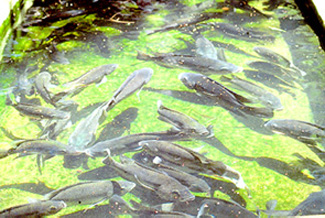
Tilapia grow well in improved fish tanks enabling commercial production.
After 6 months Elodea weeds clogged the ponds and Biomphalaria snails multiplied into millions. The weed eating fish Tilapia zillii did the job successfully wiping out Elodea weed completely wherever it was introduced and Biomphalaria snails were eaten out by smaller snails called Oncomelania. After a year one had to abandon the idea to sale Tilapia fish to finance the rehabilitation project. Then ponds were stocked with a mono sex Tilapia culture of carefully selected male Tilapia when the quarry floor was flooded in May 1972. The struggle continued with breeding fish in ponds and quite a lot of experience has been gained since. Now-a-days one finds the "Bamburi Tilapia" on restaurants menu up and down the Coast near Mombasa.
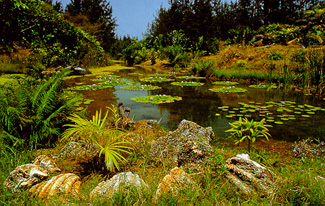
View from the paradise from cover page of the reference book.
HIPPOPOTAMUSES "SALLY" AND "POTTY" - AN INSEPARABLE COUPLE
René spent a lot of his time in the African bush listening to wise old men's so he learned when hippos are exterminated fish gradually die and water holes dry up in the end. Hippopotamus graze mainly at night, and when they return to waters, they disperse therein droppings and urine with their muscular tails. Thus they restore nutrients and fertilize waters so that plankton can grow there, which is vital food for the fish. Hippos swimming, walking and playing in waters keep pond sediments in motion thus preventing build-up of toxic gases. Animal constant activities also help aerating the water that is beneficial to the fish. Therefore a hippopotamus was needed for the sanctuary's new big pond urgently as one of most important link in its water system.
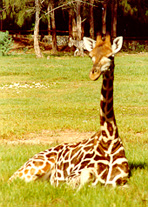
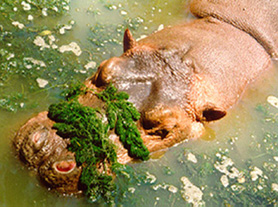
René's friends Alan and Joan Root reared a female hippo named "Sally" at their home at Naivasha Lake. Sally grew in size and unavoidably got into trouble due to her increasing appetite that she satisfied during long nightly walk-about raiding neighboring vegetable gardens too. After Sally roughly mutilated a small car parked at her favorite resting place, the "foster parents" decided to part from their "adopted" hippo transferring her to the "Bamburi Nature Park" in 1976. Sally took her time to settle down well in the surrounding. There she was rather pleased with the "suckling session" of a gallon of goat milk that took place around 5 PM every day. The same feeding time can observed today too and visitors to the park are well advised to be there on time. However, Sally and her companion Potty do get some other tidbits now.
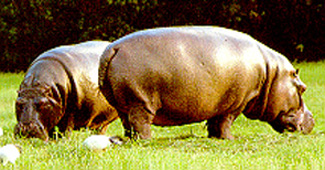
SALLY and POTTY are the main attraction to visitors of the BAMBURI
NATURE TRAIL.
The male hippo named "Potty" had a much harder adolescence as he was confiscated from a German traveling zoo. Potty had no access to water at all and his skin had dried up and cracked too and his ears were half frozen off in unfriendly European climate. Potty was a sorry sight and no zoo would accept him when the Organization for Protection of Animals "Pro Fauna" came to his rescued. The "German Cargo" arranged for his transport by air to Nairobi from where Potty was transferred on a suitable lorry to the "Bamburi Nature Park". There a new large and fenced off pond was awaiting him that must have been a welcome sight for that unhappy and tormented hippo. Potty reveled in the water during daytime and for weeks one could see his nostrils, ears and eyes protruding out only. At night he left the pond to graze at the edges shyly exploring his new surroundings too. On one of his nightly wanderings Potty discovered Sally who, on her behalf, seemed to take an instant liking to him. It was a welcome surprise as Sally had shown a territorial behavior irrational for a female hippo up this times pursuing all newcomers like a steamroller in the newly created animals' enclosure. The friendship between "Potty" and "Sally grew rapidly and they are now an inseparable couple as anybody can view during afternoon's feeding time at 17 hours day by day.
VALUABLE LIVING GARBAGE CONVERTERS - THE CROCODILES
Crocodiles are useful to the water system as they gorge on animal carcasses that aren't good for humans. The waste from the fish farm was collected as food for crocodiles as well as the offal from the "Baobab Farm" like from sheep, goats, cattle and chickens. Crocodiles perfectly convert any foodstuff because they need a little energy for their body thermal regulation as cold-blooded animals. Thus they transform the waste into valuable commodities like crocodile skins and meat for human consumption. You can taste the excellent crocodile's steak in the restaurant at the natural surrounding of this sanctuary - next to a fishpond with free crocodiles swimming around too.
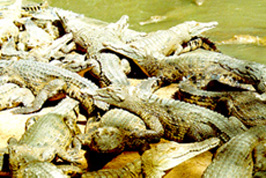
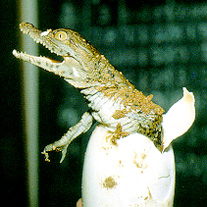
Crocodiles
sun basking motionless in their pen.
A hatchling breaks through the egg.
First Crocodylus niloticus (Nile crocodiles) were brought to the "Bamburi Quarry" in 1975 as eggs and hatchlings from Lake Turkana, Lake Baringo and the Tana River. Few females are laying eggs regularly since 1986 and some others have reached a respectable size of over 3.50m by 1994. In December every year one collects between 25 to 40 eggs from each female and to be incubated artificially afterwards. With females increasing size and age the egg weights and numbers increase too as well as the hatchlings' survival rate. Under optimum conditions crocodiles can grow in length up to 3 millimeters per day but in the quarry situation their growth is 1-1,5 millimeters only. The temperatures there is often below the ideal requirement and the crocodiles are somehow stressed or disturbed by park's visitors too. Nevertheless they reach the marketable size of 150 centimeters in say 2,5-3 years in the controlled conditions of the "crocodile's farm" these days.
THE DISPERSAL OF VEGETATION BY HERBIVORES
ORYX ANTELOPES IN THE WILD
The fringe cared Oryx gazella callotis live in rather dense thorny and dry bush areas and are rather shy and wary antelopes taking into flight at any sight of disturbance. Their ear's tip is fringed with black hairs and the tuffs are rather apparent. Females have slender horns growing longer (up to 110 cm) than those of males more massive horns. The horns are efficient weapons against predators and deadly injuries often occur during dominance fights between males. Oryx males, females and their offspring live compatibly in herds and their social structure makes the domestication and herding easier.
The Oryx is well adapted to extreme desert conditions by the efficient water conservation and little need of drink. The dense hair coat serves as an effective heat shield and the light coloration helps heat reflection better than at dark colored animals like buffaloes. Oryx reduces the heat stress in extremely hot and dry habitats letting the body temperature to rise by several degrees, thus reducing water loss for transpiration of body cooling too. Also the blood stream to brain is cooled down in the nasal region preventing brain damage. The fecal pellets are hard and dry, and the urine is highly concentrated to save on water. The milk for calves is highly concentrated and nutritious too. These anatomical and physiological adaptations require selective feeding grazing on moist grasses of early morning dew and dig tubers and roots full of moisture in very dry areas - thus making them almost independent of regular watering places. The social structuring and adaptation to harsh environments with highly efficient conversion of fibrous and poor quality grass, makes Oryx antelopes a promising species for domestication. The ancient Egyptian kept great herds of domesticated Oryx antelopes due to their superior meat quality too.
ANTELOPES IN THE REVITALIZED QUARRIES
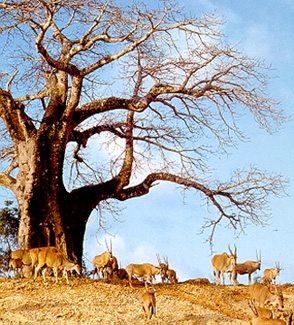
Eland and Oryx search for food under a giant "Baobab tree".
Few helpers from the "Baobab Farm" herded successfully large antelopes Eland (Taurotragus Oryx) and Oryx in the bush covered land leased to the Company where they stayed during daytime. By evenings herds were returned to "night enclosures'' where they found plenty of fodder if still hungry. Antelopes' grazing and browsing areas were used up more and more by excavating machines. By 1987 it became necessary to move the game herds moved to those already exhausted quarry's areas where a variety of grasses and herbs grew already but their "night boma" remained in the old bush area. The level of domestication depended entirely on herdsmen's skill and the now trained animals walk to and from over a specially designed "game crush" with a ''weigh bridge" enabling monitoring of their growth. Whilst selecting their favorite plant species the animals disperse seeds through their droppings to quarry's other parts and thus distribute plants from bush to grassland and forest.
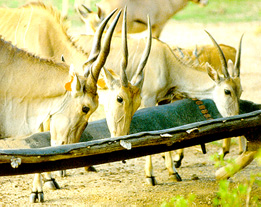
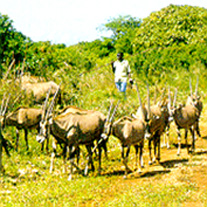
Eland antelopes feeding a trough peacefully during droughts. A herdsman
direct Oryx to a feeding area.
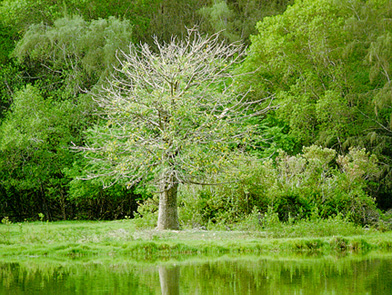
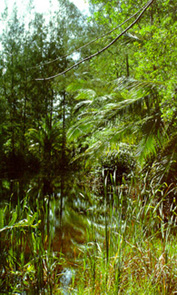
A landscape of forest, grassland and lakes with diversity of life where
once was a lifeless wasteland.
Dear readers - if you visit the Kenya's Coast near Mombasa you don't have to go far to see wildlife in a natural setting. Conservationists know Bamburi Nature Trail in the former Works quarries all over the world as a living experiment of wasteland rehabilitation. In 1987 UNEP awarded the prize "Global 500 Roll of Honor for Environmental Achievement" in recognition of the efforts and results achieved so far. It is a microcosm of a continent's age-old beauty where flora and fauna live together in great content. Go there and see for yourself! Don't miss tasting some of menu specials in the restaurant there, like steaks from crocodiles, antelopes or ostrich and Bamburi tilapia etc. Have good times and enjoy your meal!
* * * * * *
1. REHABILITATION OF A LIMESTONE QUARRY - Report of an environmental experiment by René D. Haller, Mombasa - Kenya , July 1974.
2. FROM WASTELAND TO PARADISE by René HALLER & Sabine BAER;
Copyright 1994 by R. D. Haller; Publisher: Hans H. Koschany - Germany,
1st edition 1995. The text and pictures were used with author
Dr.phil.hc. René D. Haller personal permission.